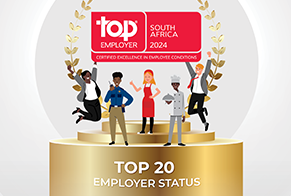The lack of diversity in many outsourced suppliers has meant that they have failed to adapt to new and changing market environments. Many service providers question whether their staff complement is diverse enough to form sustainable and collaborative relationships with their customers.
South Africa leads the world with legislation to redress the inequality of our past. Apartheid meant that the majority of our citizens were excluded from the economy as the legislation was predominantly based on race and gender. In our rush to comply with the new legislation, we are at risk of sitting back on our Black Economic Empowerment (BEE) laurels. We assume that by complying with the legislation, we are becoming more diverse. This could not be further from the truth.
As we seek to encourage more variety and diversity in our workplaces, we face greater and more complex social and cultural challenges. The psychology of actively involving people from a variety of backgrounds and experiences can spell the difference between organisational success or failure. In the business, to business services economy this is particularly important, as we seek to establish a close cultural bond with our clients.
In last weeks post the 4 Unique Benefits of Diversity in Outsourcing I outlined why diversity is so important in the outsourcing context. I set out how improving diversity can improve your competitive advantage by improving service performance, minimising risk, driving innovation and contributing positively to your overall Corporate Social Responsibility account. However implementing an effective workplace diversity plan can be overwhelming.
The following nine easy to implement steps provide a quality working outline for organisational leadership to follow when considering actively implementing a diversity strategy in the workplace.
1. Top Down Attitude
Leadership starts from the top. The attitude of top management and more particularly their actions that will be monitored and emulated by those elsewhere in the organisation. Necessity demands that senior management develops an increased awareness and knowledge of workplace diversity issues. Executives also need to recognise the corresponding legal and business risks of failing to do so. Leadership is about exhibiting the behaviour expected from the rest of the organisation. Their actions in embracing diversity and how the organisation plans to implement those changes need to be clear. For this to happen, senior management needs to be fully engaged and visible throughout the change initiative. They need to be present at workshops, during the training programs and be actively engaged and leading from the front.
2. Understanding the Purpose
Management awareness of the purpose of increasing diversity in the workplace is essential. Without a clear purpose, however, diversity will be seen as just another management initiative. “If you lose your why you’ll lose your way”. The move to a more diverse workplace is threatening to many individuals. Understanding the purpose and the benefits of diversity is, therefore, an important success factor.
The subject of gender, race, sexual orientation, ethnicity, age and educational background are not subjects that are easily discussed in a work environment. Painting a clear picture, not only of the challenges but of why this is good for business, is important to the successful implementation of the diversity plan.
People often look to the organisational diagram for clues as to what is important. If the structure supports the diversity effort, it is more likely to be taken seriously throughout the organisation. Accordingly, it can be advantageous to create a diversity office and appoint a Chief Diversity Officer (CDO). In the US, the number of Fortune 500 companies with a CDO has increased from about 20% in 2005 to about 35% in 2009.
[bctt tweet=”If you lose your why you’ll lose your way“]
3. Communicate
Communicate, communicate and communicate the diversity program and its importance to the company. The communication must be plentiful and if in doubt should err on the side of over-communication. Communication channels should include newsletters, intranet, seminars, Agora’s, videos direct from the CEO, e-mails, meetings, posters. Also, the use of social networks can help minorities build support networks and professional connections. The elimination of miscommunication is just as important, whether deliberate or otherwise.
4. Diversity Plan
A formal project plan is needed to support the diversity strategy. The plan should have clear, measurable objectives that are integrated into the rest of the company’s strategic objectives and operations. The project plan should not underestimate the time it may take to cultivate a mindset that acknowledges that diversity is part of the overall strategy. The plan needs to be rolled out well in advance to ensure that the purpose and role of diversity in the workplace have been well understood. If this is not carefully planned, critical elements will not receive the proper attention or will be omitted altogether.
As the plan to diversify the workplace evolves, it becomes important to monitor the progress and implement changes to courses of action observed not to be working effectively. Integral to this step is broadcasting the culture of acceptance across the entire organisation. When management shows interest and dedication by managing the plan, the workforce tends to be more accepting and interested in the success of the diversity plan.
5. Human Resources (HR) Initiatives
Leadership needs to change the focus of all HR initiatives to include diversity.
Recruitment is the critical HR process that must be the centre of attention. Research shows that an interviewer will most often offer a job to a person who is similar unless this natural bias is not overcome through priming and training. A company should consider how it can reach a wider talent pool such as
- Communicating the purpose of targeting diverse employees,
- Encouraging employee referrals,
- Establishing long-term relationship with minority organisations
- Advertising in minority magazines
- Interviewing potential candidates for diversity competency.
HR management needs to ensure closer coordination among agencies, recruitment managers and human resource personnel. Both internal and external recruiting resources need to know the business objectives and set realistic expectations for all concerned. Most importantly, management needs to identify and implement lessons learned from each hire what worked and what didn’t work.
Development initiatives should include special preparation programs for minorities in areas such as language, culture and technical training.
Companies should review existing complaint/grievance processes to ensure diversity sensitivity as well as thorough and comprehensive investigation. Where necessary a trained professional should be hired to respond to complaints and provide impartial investigation and recommendations. Companies should also consider alternative independent dispute resolution mechanisms such as mediation, arbitration or peer review.
Involve and train line managers in issues such as willingness and ability to listen, discouraging stereotyping, understanding that their behaviour can mean missed opportunities for performance and discomfort for the people involved.
6. Promoting Diversity
Promoting individuals of diverse backgrounds up the chain of command is the subject of much controversy. If directors and executives of the company accept and embrace the diversity program, then merit based, internal promotions should be easy to install in company operations.
Special attention needs to be paid to promoting minority employees and ensuring that those who do become managers, display diversity competency. We should not underestimate the effect that positive role models can play in the workplace. The precepts of an acceptable and successful workplace diversity program are considered to be in place and working well.
The precepts of an acceptable and successful workplace diversity program is considered to be in place and working well when others, both internal to the business, as well as those looking in from the outside, see the company’s dedication to advancing those who deserve the opportunity, regardless of their race, sex, or creed.
Talent retention programs should specifically target previously disadvantaged groups. Mentoring and support programs should include participants from minority groups. Other policies may include reimbursement of educational costs, financial support for diversity initiatives, etc.
[bctt tweet=”Talent retention programs should specifically target previously disadvantaged groups”]
7. Workforce Data
In many countries, it is mandatory to create and maintain a validated employment database containing relevant diversity data. This is often seen as a compliance issue only and consequently little is done to monitor and analyse trends. This is a rich vein of data that should be acted upon to ensure equitable appointment processes, compensation, discipline and promotion practices for all employees. There should be a concerted effort to increase levels of executive management awareness of and involvement in regular reporting to the highest level of management on workforce data and trends.
There should be an annual review of applicable policies and procedures by the legal department or outside experts and an ongoing demand for consistent application and enforcement of all policies. Disciplinary action should be taken against supervisors and managers who fail to consistently enforce the policies.
8. Targets
Leadership should be setting aggressive but achievable annual targets for diversity hiring and promotions by managers. The use of ’diversity scorecards’ and benchmarking standards track progress and demonstrate opportunities and placements to your customers and your workforce. High-level managers and other key employees should have diversity targets incorporated into their performance objectives. The project should also include a performance evaluation program that functions as an accountability mechanism.
9. Assess and Communicate the Progress
This step must be a conscious effort on the part of the organisation. Effective assessment includes collecting data, on employee attitudes, effects of diversity on productivity and the cost associated with plan implementation. Once the information is available making sound choices, can keep a plan on track and moving towards its stated goals.
Communication allows all staff to follow the progress of the initiative and see where additional effort can be focused.
Conclusion
To build teams or organisations capable of innovating, you need diversity. Diversity enhances creativity. It encourages the search for novel information and perspectives, leading to better decision making and problem-solving. Diversity can improve the bottom line of companies and lead to unfettered discoveries and breakthrough innovations. This conclusion it is drawn from decades of research from organisational scientists, psychologists, sociologists, economists and demographers.
Many organisations still struggle with implementing a robust diversity and inclusion agenda and embed it into their Business Plan. This results in failure to fulfil the maximum potential of a diverse and inclusive workforce.
What diversity initiatives are there in your workplace and what benefits have you seen? Leave your comments below



